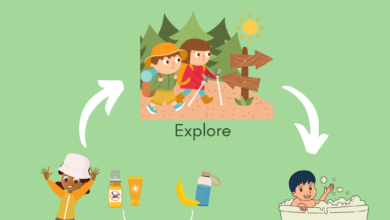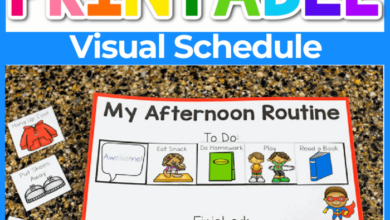
Allowing Kids to Do Hard Things: Building Resilience and Success
Allowing kids to do hard things isn’t about pushing them to the brink, it’s about nurturing their growth by creating opportunities for them to step outside their comfort zones. This philosophy fosters resilience, problem-solving skills, and self-confidence, equipping them to face challenges with courage and determination.
It’s about recognizing that failure is not the end, but a valuable learning experience that paves the way for future success.
By providing children with age-appropriate challenges, parents can guide them on a journey of self-discovery and empower them to become independent, capable individuals. This journey isn’t without its bumps, but the rewards are immense, shaping children into well-rounded individuals who are prepared to navigate the complexities of life with confidence and resilience.
Benefits of Allowing Kids to Do Hard Things
The act of encouraging children to engage in challenging tasks, despite the potential for setbacks and discomfort, is a powerful investment in their future. By providing opportunities for children to stretch their abilities and navigate obstacles, we cultivate a sense of resilience, problem-solving prowess, and self-assurance that will serve them well throughout their lives.
Resilience: The Power to Bounce Back
Resilience, the ability to adapt and thrive in the face of adversity, is a cornerstone of a successful life. When children encounter difficulties, they learn to persevere, develop coping mechanisms, and build a sense of inner strength. Allowing children to tackle challenges fosters resilience by:
- Providing opportunities for failure:Failure is an essential ingredient in the recipe for resilience. When children are allowed to fail, they learn to view setbacks as learning experiences rather than defeats. They develop the ability to analyze their mistakes, adjust their strategies, and try again.
Letting kids tackle challenges, even if they seem daunting, is a gift. It’s about fostering resilience and building confidence. Those moments of struggle, the triumphs and setbacks, are the raw materials of life lessons. And just like the memories saved in seconds keep a memory box , these experiences shape who they become.
So, encourage them to push their limits, to stumble, and to rise again. The journey, not just the destination, is where the magic happens.
- Building a growth mindset:Resilience is closely tied to a growth mindset, the belief that abilities can be developed through effort and perseverance. When children are encouraged to embrace challenges, they develop a sense of agency and the belief that they can overcome obstacles through hard work and determination.
- Teaching valuable life lessons:Resilience is not just about bouncing back from setbacks; it’s also about learning from those experiences and applying those lessons to future challenges. By allowing children to face difficulties, we equip them with the skills and insights they need to navigate life’s inevitable ups and downs.
Examples of “Hard Things” for Kids

Helping children embrace challenges is crucial for their development. By encouraging them to tackle “hard things,” we foster resilience, problem-solving skills, and a sense of accomplishment. This section explores age-appropriate examples of challenges that kids can face, ranging from learning new skills to taking on responsibilities at home.
It’s easy to want to shield our kids from the tough stuff, but letting them face challenges, even small ones, builds resilience and confidence. It’s like how you wouldn’t dream of staying inside on a chilly day without a cozy sweater – who doesn’t just love a sweater when it’s cold outside ! Similarly, allowing kids to navigate challenges, big or small, helps them develop the strength to face the world with a warm, confident heart.
Examples of Age-Appropriate Challenges
| Age Group | Challenge | Skills Developed | Potential Benefits |
|---|---|---|---|
| 2-4 years old | Putting on their own shoes and socks | Fine motor skills, independence, self-sufficiency | Boosts confidence, promotes a sense of accomplishment, prepares them for future challenges |
| 4-6 years old | Learning to ride a bike without training wheels | Balance, coordination, motor skills, risk-taking | Improves physical abilities, enhances self-esteem, develops perseverance |
| 6-8 years old | Learning to play a musical instrument | Discipline, patience, focus, creativity | Develops cognitive abilities, enhances memory, fosters a love for music |
| 8-10 years old | Helping with chores around the house | Responsibility, teamwork, organization, time management | Fosters a sense of belonging, teaches valuable life skills, promotes family unity |
| 10-12 years old | Starting a new hobby or extracurricular activity | Problem-solving, critical thinking, social skills, communication | Expands interests, builds confidence, develops leadership qualities |
| 12-14 years old | Taking on a part-time job or volunteer opportunity | Work ethic, financial responsibility, social interaction, empathy | Develops independence, teaches valuable life skills, builds character |
Parental Role in Facilitating Challenges
The journey of raising resilient and capable children is paved with challenges. While it’s natural for parents to want to shield their children from difficulties, allowing them to navigate challenges is crucial for their growth and development. Parental support plays a vital role in this process, providing a framework for children to explore, learn, and thrive.Parents can foster an environment where children feel safe to try new things, make mistakes, and learn from their experiences.
It’s amazing to watch kids rise to challenges, even when they seem tough. It builds resilience and confidence, which are invaluable life skills. And as we celebrate the amazing women in our lives on Mother’s Day, remember that empowering our kids to face their fears is a gift that keeps on giving.
Check out some inspiring mothers day ideas that celebrate the strength and love of motherhood. Ultimately, allowing kids to do hard things isn’t just about the task itself, it’s about the growth they experience along the way.
This environment is characterized by open communication, empathy, and a belief in the child’s capabilities. By creating a safe space for exploration, parents empower their children to embrace challenges as opportunities for growth.
Creating a Safe and Encouraging Environment
Parents can create a safe and encouraging environment for their children by:
- Providing a safe space for mistakes:Children need to know that it’s okay to make mistakes, and that these mistakes are valuable learning opportunities. Parents can encourage this by refraining from harsh criticism or punishment, and instead focusing on understanding the child’s perspective and helping them learn from their errors.
- Expressing confidence in their child’s abilities:Children are more likely to take on challenges if they believe in themselves. Parents can foster this belief by expressing confidence in their child’s abilities and encouraging them to persevere even when things get tough.
- Offering support and guidance:While children should be encouraged to take ownership of their challenges, parents can provide support and guidance along the way. This can include offering advice, providing resources, or simply being a listening ear when needed.
Helping Children Set Achievable Goals
Setting achievable goals is essential for children to experience success and build confidence. Parents can help their children set goals by:
- Involving them in the goal-setting process:Children are more likely to be motivated by goals they have helped to create. Parents can involve their children in the goal-setting process by discussing their interests, aspirations, and what they hope to achieve.
- Breaking down large goals into smaller steps:Large goals can seem overwhelming. Parents can help their children break down large goals into smaller, more manageable steps, making the journey seem less daunting.
- Setting realistic expectations:It’s important to set realistic expectations for children, considering their age, skills, and experience. Setting goals that are too challenging can lead to frustration and discouragement.
Breaking Down Tasks
Breaking down tasks into smaller, manageable steps can help children feel less overwhelmed and more confident in their ability to complete them. Parents can help children break down tasks by:
- Creating a list of steps:Working together, parents and children can create a list of steps involved in completing a task. This visual representation can help children see the process more clearly and feel less overwhelmed.
- Prioritizing tasks:Children can learn to prioritize tasks by identifying the most important steps and tackling them first. This can help them stay focused and make progress towards their goal.
- Setting deadlines:Setting deadlines can help children stay on track and avoid procrastination. Parents can work with their children to set realistic deadlines that allow for adequate time to complete each step.
Celebrating Successes
Celebrating successes, no matter how small, is crucial for reinforcing positive behavior and motivating children to continue striving. Parents can celebrate their children’s successes by:
- Acknowledging effort and progress:Parents should acknowledge their child’s effort and progress, even if they don’t achieve the desired outcome. This reinforces the importance of trying and persevering.
- Providing positive reinforcement:Parents can provide positive reinforcement through verbal praise, hugs, or small rewards. This helps children feel valued and motivated to continue working hard.
- Creating opportunities for recognition:Parents can create opportunities for their children to be recognized for their accomplishments, such as sharing their work with family and friends or displaying their creations.
Addressing Concerns and Potential Risks
It’s natural to have concerns when encouraging children to embrace challenges. The fear of failure, potential for injury, and anxieties about their well-being are all valid considerations. However, with careful planning, appropriate supervision, and open communication, these risks can be mitigated, allowing children to reap the benefits of pushing their limits.
Addressing Fear of Failure
Fear of failure is a common concern among parents. Children may be hesitant to try new things if they are afraid of making mistakes or disappointing their parents. It’s important to remember that failure is a natural part of learning.
It’s an opportunity for growth and development. Parents can help their children overcome the fear of failure by:
- Reframing failure as a learning opportunity:Instead of focusing on the outcome, emphasize the effort and the lessons learned. Encourage children to see mistakes as stepping stones to success.
- Modeling a growth mindset:Parents should show their children that they are not afraid to take risks and learn from their mistakes. Sharing personal experiences of overcoming challenges can inspire children to embrace their own.
- Creating a safe space for experimentation:Encourage children to try new things without fear of judgment or punishment. Provide opportunities for them to practice and make mistakes in a supportive environment.
Addressing Potential for Injury
When children are involved in challenging activities, there is always a risk of injury. It’s important to take precautions to minimize these risks.Parents can mitigate the risk of injury by:
- Providing proper equipment and safety gear:Make sure children have the necessary equipment and safety gear for the activity they are participating in. This may include helmets, pads, or other protective gear.
- Ensuring proper training and supervision:Children should receive proper training in the activity they are undertaking. Parents should also supervise their children closely, especially when they are first learning a new skill.
- Setting clear boundaries and expectations:Establish clear rules and boundaries for the activity. Children should understand the risks involved and the importance of following safety protocols.
Addressing Parental Anxieties
Parents may worry about their children’s well-being when they are facing challenges. It’s important to address these anxieties and provide reassurance.Parents can alleviate their anxieties by:
- Communicating openly with their children:Talk to your children about their fears and concerns. Listen to their perspectives and offer support and encouragement.
- Trusting their children’s abilities:Children are often capable of more than their parents realize. Give them the opportunity to demonstrate their skills and abilities.
- Focusing on the process rather than the outcome:Encourage children to focus on the journey of learning and growth, rather than solely on the final result.
The Importance of Failure
Failure is an inevitable part of life, and it’s especially important for children to understand this. While we naturally want to protect our children from hurt and disappointment, shielding them from failure can actually hinder their growth and development. Embracing failure as a learning opportunity allows children to build resilience, develop problem-solving skills, and ultimately achieve greater success in the long run.
Understanding Failure as a Stepping Stone
It’s crucial to help children see failure not as an end, but as a valuable stepping stone on the path to success. We can do this by reframing failure as a learning experience. Instead of focusing on the negative outcome, emphasize the lessons learned and the opportunities for growth.
For example, if a child struggles with a math problem, instead of saying “You failed,” we can say, “That’s a tough problem! What can we try next time to solve it?” This approach encourages a growth mindset, where challenges are viewed as opportunities to learn and improve.
Strategies for Encouraging Learning from Mistakes
There are several effective strategies we can use to encourage children to learn from their mistakes:
- Encourage open communication:Create a safe space where children feel comfortable sharing their failures and their thoughts about them. Listen attentively and validate their feelings without judgment.
- Focus on the process, not just the outcome:Emphasize the effort and strategies employed, rather than just the final result. This helps children understand that even when they don’t succeed, they’re still learning and growing.
- Celebrate small victories:Acknowledge and celebrate every step forward, no matter how small. This helps children stay motivated and build confidence even when facing setbacks.
- Model a growth mindset:Children learn by observing the adults around them. Be open about your own failures and how you learn from them. This shows children that it’s okay to make mistakes and that failure is a natural part of life.
The Impact on Future Success: Allowing Kids To Do Hard Things
Allowing children to embrace challenges and do hard things is not merely about building resilience; it’s a powerful investment in their future success. The skills they cultivate through navigating difficult tasks and overcoming obstacles translate into valuable assets for navigating the complexities of adult life, from academic pursuits to professional careers and personal relationships.
The Link Between Challenges and Academic Success, Allowing kids to do hard things
The ability to persevere through challenging tasks is directly linked to academic success. Children who have been encouraged to tackle difficult problems, whether in academics or extracurricular activities, develop crucial skills such as problem-solving, critical thinking, and time management. These skills are essential for excelling in school, mastering complex subjects, and achieving academic goals.
Developing Essential Skills for Career Success
The workplace is a demanding environment where individuals constantly face new challenges and unforeseen situations. Children who have been allowed to do hard things develop a growth mindset, an essential attribute for professional success. They learn to embrace challenges as opportunities for growth, adapt to change, and work diligently towards achieving their goals.
They are also more likely to be resourceful, innovative, and collaborative, qualities highly valued in today’s dynamic work environments.
Building Resilience for Personal Life
Beyond academics and careers, the ability to handle challenges is crucial for personal well-being and happiness. Children who have learned to persevere through difficult situations develop emotional resilience. They learn to cope with setbacks, bounce back from failures, and navigate the inevitable ups and downs of life.
This resilience is invaluable for maintaining healthy relationships, overcoming personal obstacles, and leading fulfilling lives.
Examples of Individuals Who Embraced Challenges
Countless individuals have demonstrated the positive impact of embracing challenges in their childhood. For example, J.K. Rowling, the author of the beloved Harry Potter series, faced numerous rejections from publishers before finding success. Her perseverance and unwavering belief in her story ultimately led to the creation of a global phenomenon.
Similarly, Oprah Winfrey, a media mogul and philanthropist, overcame a challenging childhood to become one of the most influential figures in the world. Her ability to embrace challenges and turn adversity into opportunity is a testament to the power of resilience.






